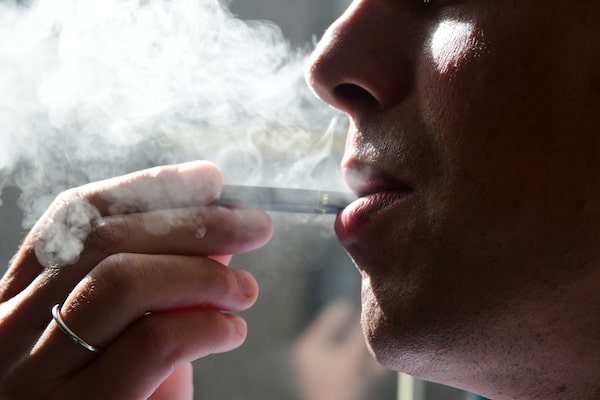
A man exhales smoke from an electronic cigarette, in Washington, on Oct. 2, 2018.EVA HAMBACH/AFP/Getty Images
Researchers in Britain have released one of the most comprehensive examinations of the health effects of vaping and concluded that while vaping is 95 per cent less harmful than smoking, it is not risk-free.
The researchers, from King’s College London, spent three years reviewing data from surveys of vaping behaviour, as well as results of more than 400 scientific studies around the world.
“Based on the entirety of the evidence that we reviewed, we conclude that vaping poses only a small fraction of the risks of smoking in the short to medium term. But this doesn’t mean vaping is risk free particularly for people who have never smoked,” said Ann McNeill, a professor of tobacco addiction at King’s College.
Health officials in Britain have long touted the benefits of vaping as a way of encouraging smokers to quit. The major health concern about smoking hasn’t been nicotine as much as the toxins that are inhaled from burning cigarettes. Officials argue that e-cigarettes can deliver similar amounts of nicotine without the dangerous chemicals.
In 2015, a group of researchers in Britain announced that vaping was 95 per cent less harmful than cigarettes. Many scientists criticized that conclusion for being too simplistic and premature, because there hadn’t been enough long-term studies of vaping.
Dr. McNeill told a news briefing on Thursday the King’s College findings vindicated the 95-per-cent calculation. The current research has confirmed the percentage “remains broadly accurate, at least over short term and medium term periods,” she said.
The report examined a range of biomarkers for various toxicants related to smoking and vaping that measure harmful substances in the body. The biomarkers included nicotine, carbon monoxide, tobacco-specific nitrosamines, volatile organic compounds and metals.
The researchers found there was “significantly lower exposure to harmful substances from vaping compared with smoking, as shown by biomarkers associated with the risk of cancer, respiratory and cardiovascular conditions.”
They also concluded there was “no significant increase of toxicant biomarkers after short-term second-hand exposure to vaping among people who do not smoke or vape.” And they found that there was “limited evidence” some vape flavours – particularly cinnamon, buttery or creamy – have the potential to alter cells, but less than exposure to tobacco smoke.
However, the report said people who vaped were exposed to some harmful substances compared to those who didn’t use e-cigarettes or who didn’t smoke. Dr. MacNeill said only a handful of studies had been done on that subject, and the health effects of vaping versus not vaping still aren’t clear.
“If you’re taking something down into your lungs on a regular and sustained period of time for 20 or 30 years, there are likely to be risks associated with that,” she said. “By saying vaping isn’t risk-free, we are being cautious.”
The overall conclusion of the report, she added, is that vaping can be used as an alternative to smoking, but people who have never smoked, or who gave up smoking a long time ago, should be discouraged from taking up vaping.
Debbie Robson, a senior lecturer in tobacco harm reduction at King’s, said more work is also needed to determine the harmful effects of nicotine.
“We know the long-term effects of nicotine in smoking, less so about the long-term effects of nicotine on its own and isolated,” Dr. Robson told the news conference. High exposure to nicotine “may well affect cardiovascular health. It isn’t going to affect things like cancer and less so respiratory health,” she said. “But it’s always going to be better to have the nicotine not in tobacco smoke, in some other form.”
Like many western countries, smoking has been in a slow but steady decline in Britain, while vaping has been rising. Most of the vapers are ex-smokers and the report noted that services that help smokers quit have found that vaping was the most effective product. Just over 64 per cent of quitting attempts that involved vaping were successful, the report said, compared to 58 per cent that used nicotine patches, gum or other products.
Dr. Robson expressed some caution about the increasing number of people vaping. “We are concerned about the uptick in vaping among people,” she said. “We wouldn’t encourage young people, if they’ve not smoked, to take up vaping or take up smoking.”